Younghak Shin
Accurate Real-time Polyp Detection in Videos from Concatenation of Latent Features Extracted from Consecutive Frames
Mar 10, 2023Abstract:An efficient deep learning model that can be implemented in real-time for polyp detection is crucial to reducing polyp miss-rate during screening procedures. Convolutional neural networks (CNNs) are vulnerable to small changes in the input image. A CNN-based model may miss the same polyp appearing in a series of consecutive frames and produce unsubtle detection output due to changes in camera pose, lighting condition, light reflection, etc. In this study, we attempt to tackle this problem by integrating temporal information among neighboring frames. We propose an efficient feature concatenation method for a CNN-based encoder-decoder model without adding complexity to the model. The proposed method incorporates extracted feature maps of previous frames to detect polyps in the current frame. The experimental results demonstrate that the proposed method of feature concatenation improves the overall performance of automatic polyp detection in videos. The following results are obtained on a public video dataset: sensitivity 90.94\%, precision 90.53\%, and specificity 92.46%
Simple U-net Based Synthetic Polyp Image Generation: Polyp to Negative and Negative to Polyp
Feb 20, 2023Abstract:Synthetic polyp generation is a good alternative to overcome the privacy problem of medical data and the lack of various polyp samples. In this study, we propose a deep learning-based polyp image generation framework that generates synthetic polyp images that are similar to real ones. We suggest a framework that converts a given polyp image into a negative image (image without a polyp) using a simple conditional GAN architecture and then converts the negative image into a new-looking polyp image using the same network. In addition, by using the controllable polyp masks, polyps with various characteristics can be generated from one input condition. The generated polyp images can be used directly as training images for polyp detection and segmentation without additional labeling. To quantitatively assess the quality of generated synthetic polyps, we use public polyp image and video datasets combined with the generated synthetic images to examine the performance improvement of several detection and segmentation models. Experimental results show that we obtain performance gains when the generated polyp images are added to the training set.
Confidence-Aware Learning for Deep Neural Networks
Jul 07, 2020
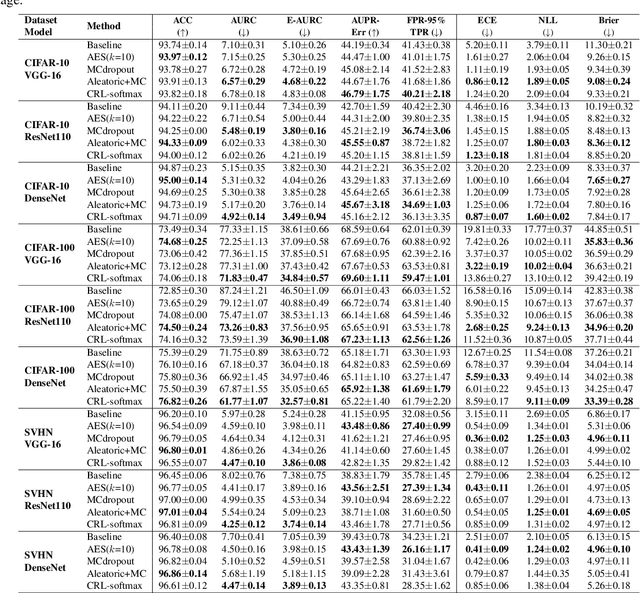
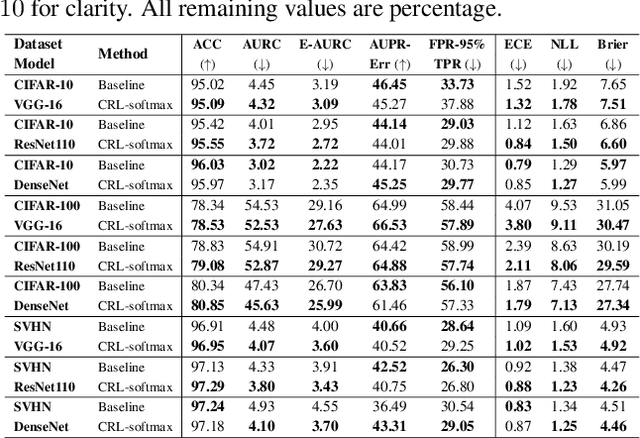
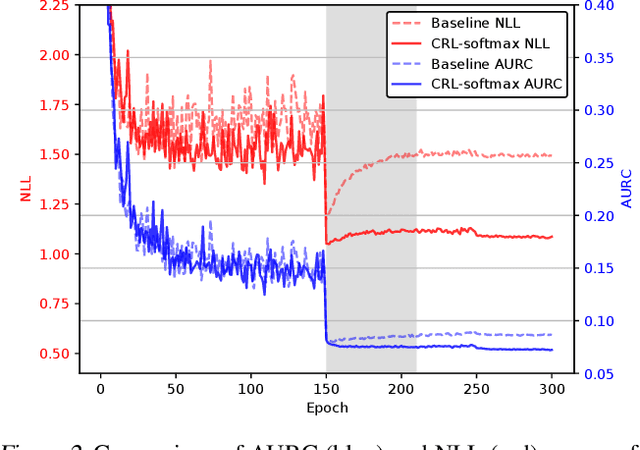
Abstract:Despite the power of deep neural networks for a wide range of tasks, an overconfident prediction issue has limited their practical use in many safety-critical applications. Many recent works have been proposed to mitigate this issue, but most of them require either additional computational costs in training and/or inference phases or customized architectures to output confidence estimates separately. In this paper, we propose a method of training deep neural networks with a novel loss function, named Correctness Ranking Loss, which regularizes class probabilities explicitly to be better confidence estimates in terms of ordinal ranking according to confidence. The proposed method is easy to implement and can be applied to the existing architectures without any modification. Also, it has almost the same computational costs for training as conventional deep classifiers and outputs reliable predictions by a single inference. Extensive experimental results on classification benchmark datasets indicate that the proposed method helps networks to produce well-ranked confidence estimates. We also demonstrate that it is effective for the tasks closely related to confidence estimation, out-of-distribution detection and active learning.
Bin-wise Temperature Scaling (BTS): Improvement in Confidence Calibration Performance through Simple Scaling Techniques
Sep 23, 2019
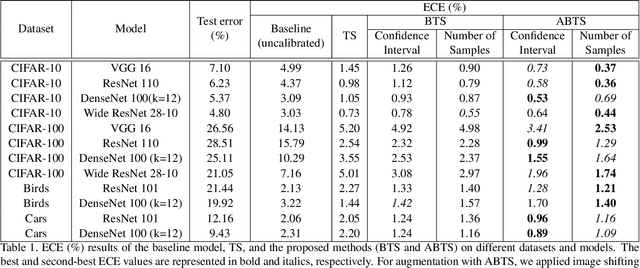

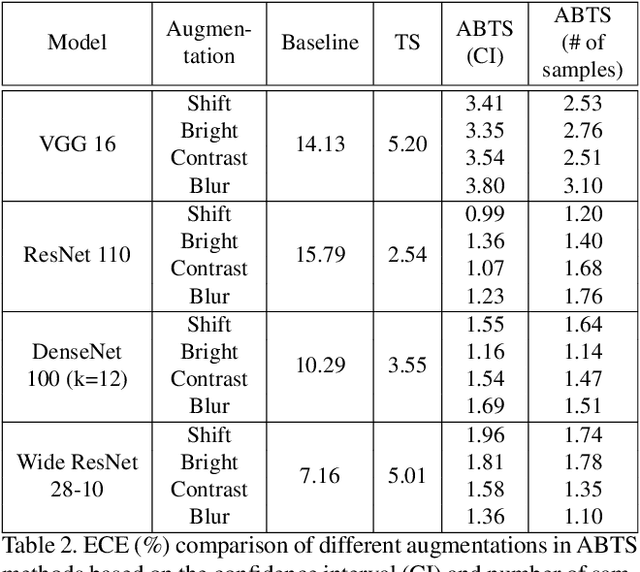
Abstract:The prediction reliability of neural networks is important in many applications. Specifically, in safety-critical domains, such as cancer prediction or autonomous driving, a reliable confidence of model's prediction is critical for the interpretation of the results. Modern deep neural networks have achieved a significant improvement in performance for many different image classification tasks. However, these networks tend to be poorly calibrated in terms of output confidence. Temperature scaling is an efficient post-processing-based calibration scheme and obtains well calibrated results. In this study, we leverage the concept of temperature scaling to build a sophisticated bin-wise scaling. Furthermore, we adopt augmentation of validation samples for elaborated scaling. The proposed methods consistently improve calibration performance with various datasets and deep convolutional neural network models.
Polyp Detection and Segmentation using Mask R-CNN: Does a Deeper Feature Extractor CNN Always Perform Better?
Jul 22, 2019
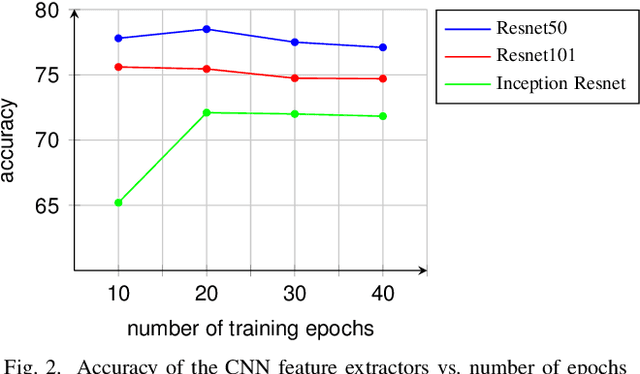


Abstract:Automatic polyp detection and segmentation are highly desirable for colon screening due to polyp miss rate by physicians during colonoscopy, which is about 25%. However, this computerization is still an unsolved problem due to various polyp-like structures in the colon and high interclass polyp variations in terms of size, color, shape, and texture. In this paper, we adapt Mask R-CNN and evaluate its performance with different modern convolutional neural networks (CNN) as its feature extractor for polyp detection and segmentation. We investigate the performance improvement of each feature extractor by adding extra polyp images to the training dataset to answer whether we need deeper and more complex CNNs or better dataset for training in automatic polyp detection and segmentation. Finally, we propose an ensemble method for further performance improvement. We evaluate the performance on the 2015 MICCAI polyp detection dataset. The best results achieved are 72.59% recall, 80% precision, 70.42% dice, and 61.24% Jaccard. The model achieved state-of-the-art segmentation performance.
* 6
Abnormal Colon Polyp Image Synthesis Using Conditional Adversarial Networks for Improved Detection Performance
Jun 27, 2019



Abstract:One of the major obstacles in automatic polyp detection during colonoscopy is the lack of labeled polyp training images. In this paper, we propose a framework of conditional adversarial networks to increase the number of training samples by generating synthetic polyp images. Using a normal binary form of polyp mask which represents only the polyp position as an input conditioned image, realistic polyp image generation is a difficult task in a generative adversarial networks approach. We propose an edge filtering-based combined input conditioned image to train our proposed networks. This enables realistic polyp image generations while maintaining the original structures of the colonoscopy image frames. More importantly, our proposed framework generates synthetic polyp images from normal colonoscopy images which have the advantage of being relatively easy to obtain. The network architecture is based on the use of multiple dilated convolutions in each encoding part of our generator network to consider large receptive fields and avoid many contractions of a feature map size. An image resizing with convolution for upsampling in the decoding layers is considered to prevent artifacts on generated images. We show that the generated polyp images are not only qualitatively realistic but also help to improve polyp detection performance.
* 10 pages
Automatic Colon Polyp Detection using Region based Deep CNN and Post Learning Approaches
Jun 27, 2019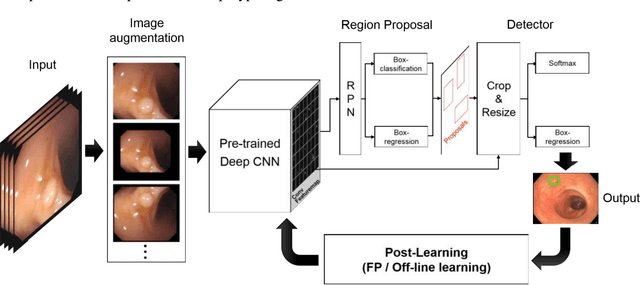



Abstract:Automatic detection of colonic polyps is still an unsolved problem due to the large variation of polyps in terms of shape, texture, size, and color, and the existence of various polyp-like mimics during colonoscopy. In this study, we apply a recent region based convolutional neural network (CNN) approach for the automatic detection of polyps in images and videos obtained from colonoscopy examinations. We use a deep-CNN model (Inception Resnet) as a transfer learning scheme in the detection system. To overcome the polyp detection obstacles and the small number of polyp images, we examine image augmentation strategies for training deep networks. We further propose two efficient post-learning methods such as, automatic false positive learning and off-line learning, both of which can be incorporated with the region based detection system for reliable polyp detection. Using the large size of colonoscopy databases, experimental results demonstrate that the suggested detection systems show better performance compared to other systems in the literature. Furthermore, we show improved detection performance using the proposed post-learning schemes for colonoscopy videos.
* 9 pages
 Add to Chrome
Add to Chrome Add to Firefox
Add to Firefox Add to Edge
Add to Edge